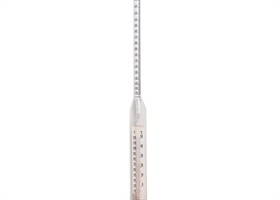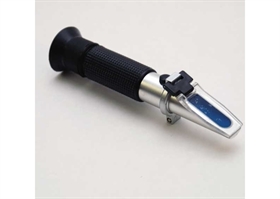Refractometer Accuracy Test
A while back I picked up a refractometer from Northern Brewer to use instead of the hydrometer I'd had for so long. While it was certainly a great deal more convenient I was starting to get suspicious about it's accuracy. So I pitted it against my hydrometer in a challenge to the death! Spoiler: the refractometer matched the hydrometer point for point. And, in point of fact, neither of these instruments was killed during the challenge. Read on for boring tables and such.
CHALLENGER THE FIRST - thermohydrometer from Midwest Brewing, bought several years ago.
Principals of Operation: you extract a couple hundred ml of wort, must, or whatever you want to measure and decant it into a cylinder the same height and slightly wider than the hydrometer. Drop the hydrometer into this liquid filled cylinder, wait for it to come to rest, and take a reading from the graduated markings along the top of the instrument. The hydrometer is carefully weighted so that in neutral water it will read a specific gravity of 1.000. The more dense the liquid, the higher the hydrometer will float, resulting in a high specific gravity reading.
Advantages: cheap and accurate.
Limitations: fragile glass; requires ~150ml of liquid to be carefully decanted and subsequently discarded; works best at specific temperatures (thermohydrometers also contain a simple thermometer and a temp conversion scale for when your liquid is outside of the ideal temp range); reading the meniscus can be tricky and can distort the true value by a point or two.
CHALLENGER THE SECOND - refractometer from Northern Brewer, bought last year
Principals of Operation: place a couple drops of wort, must, or whatever on the glass plate at the end of the refractometer and look through the eye piece. Light is bent through the liquid; different densities of liquid will bend light different amounts. Read the specific gravity from a scale printed on a glass pane inside the tool. The refractometer can be manually re-calibrated (using distilled water) but I have not yet needed to do so.
Advantages: simple to use; requires much less liquid for a reading; works along a wide range of temperatures.
Limitations: costs as much as five hydrometers; while easier to read than a hydrometer, it can still be tricky the get a very precise reading due to the resolution of the "line" being displayed.
PROCESS
I wanted to pit the two instruments against one another in two related scenarios: liquid of varying densities and liquids of varying temperatures. In the first test I filled the hydrometer cylinder with 150ml of tap water at 64°F (sorry for the mix of metric and imperial units - this is kitchen science, after all), dropped in the hydrometer, and took a reading. Then I pipetted a small amount onto the refractometer and took another reading. Having recorded these results I added a measured amount of table sugar to the cylinder, agitated well and repeated the process. Results:
|
Net Sugar Added (g) |
Hydrometer (S.G.) |
Refractometer (S.G.) |
|---|---|---|
| 0 | 1.000 | 1.000 |
| 1 | 1.008 | 1.008 |
| 3 | 1.015 | 1.015 |
| 6 | 1.023 | 1.022 |
| 12 | 1.039 | 1.039 |
All of those values are with the margin of error provided by my ocular examination. Good job, science. Next up: the temperature test. I filled a Pyrex measuring cup with 250ml of water, added 35g of sugar and mixed well. I decanted as much water as would fit in the cylinder, and took readings with both instruments as above. Then I poured the liquid back into the Pyrex cup, microwaved the solution, measured the temperature and repeated the process.
|
Temperature (°F) |
Hydrometer Base (S.G.) |
Temp Modifier ("points") |
Hydrometer Final (S.G.) |
Refractometer (S.G.) |
|---|---|---|---|---|
| 65 | 1.050 | 0 | 1.050 | 1.048 |
| 88 | 1.046 | +3 | 1.049 | 1.048 |
| 112 | 1.042 | +8 | 1.050 | 1.048 |
The specs for the refractometer claim it has "automatic temperature adjustment" in the range 50-86°F we see that it performed well even at 112°F.
CONCLUSION?
In all tests both the hydrometer and refractometer returned sufficiently similar results (sufficient for my needs, anyway). I now feel perfectly confident in the function and my usage of the refractometer. Feel free to reproduce these measurements using your own "test equipment" and let me know, in the comments, if your results are at all similar to mine.
BONUS ROUND
Since I was doing it, I made a couple of raw measurements (using a measuring cup and kitchen scale). 250 ml of 77°F tap water weighed 238 grams yielding a density of 0.95. That should be 1.0 but there are so many variables out of my control here that, well, whatever. Using the same process, 285 ml of a sugar/water solution (35 g sugar) at 110°F weighing 278 grams gives us a density of 0.98. The specific gravity of this sugar/water solution, relative to the measured density of plain tap water, is 1.03. We're rapidly running out of specific units but this is still well short of the 1.05 measured with both the hydrometer and refractometer. Why should this be? Let's call it sloppy science. Maybe someday I'll repeat this part of the experiment with a greater sample size to see if I can get a better value. Until then, however, let's just make beer.



